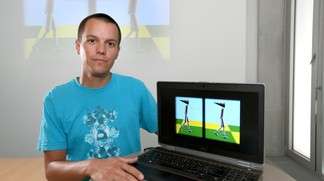Designing better prostheses through gait analysis

Our ability to put one foot in front of the other is the result of a subtle coordination between the brain and the spinal cord. Understanding this mechanism was the goal of Life Science student Steve Berger’s Master’s thesis. He hopes to help create prostheses that are better adapted to the needs of handicapped individuals.
We take it for granted, but walking on two feet is an extremely complex task. Reproducing a bipedal gait in a robot or simulating it on a computer is much more complex and involves many more parameters than one would imagine. That’s why humanoid robots or computer avatars often seem stiff and awkward.
Fascinated by neurosciences, recent life Sciences graduate Steve Berger wanted to contribute to research in this field. He was intrigued by this problem, a combination of biology and technology, and made it the subject of his Master’s thesis work. During a first-year class, he was intrigued by an article about Carnegie Mellon professor Hartmut Geyer’s research on muscle simulation. Berger immediately decided to do his research in this area.
“I reproduced one of his projects that consisted of moving a 2D computer character,” he explains. First, he had to put in place all of the character’s (which he named Regis) basic parameters, such as the number of muscles and tendons involved and their length and viscoelastic properties, as well as the intensity of basic reflexes that enabled a rudimentary two-footed gait. Then he adapted and corrected them during the course of experimentation. “In particular, I introduced the idea of energy consumption; Regis was able to optimize his efforts in order to be able to walk for longer periods of time.”
In a third phase, the young scientist is developing a model for allowing the humanoid to get over an obstacle placed on the ground. “I got the idea from a study on cats,” Berger explains. “I realized that in order for Regis to fall as little as possible, his muscles needed to be activated in a certain order, with each one exerting the right amount of 'force'.”
Subtle coordination
By doing this research, Berger is hoping to better understand the mechanism of coordinated movement, and to contribute, in the longer term, to the creation of devices and prostheses that would allow handicapped individuals not only to walk again, but also to be able to navigate difficult and uneven ground. “To do that, it’s critical to pinpoint the logic in the biology in order to build robotics that are really robust, functional and adaptable.”
Walking is a very complex function, the result of a subtle coordination between the brain and the spinal cord. As in any biological system, using simulations is very helpful in understanding the phenomenon. “It allows you to simplify the function by separating out or isolating its components, to make various hypotheses and then test them, and finally to validate them by implementing them in a robot.”
The young scientist is continuing his academic career with a PhD. He’ll continue working on bipedal gait, but now his focus will be on its cognitive aspects, particularly consciousness and the image one has of oneself during the action of walking. Berger himself admits he doesn’t walk the same as he did before he started studying walking; “Now, from time to time, I walk on my hands.”

















